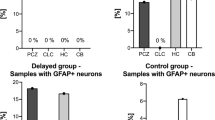Summary
Immunocytochemical staining patterns for glial fibrillary acidic protein (GFAP) and S-100 protein (S100P) were compared in cerebral cortex, basal ganglia and white matter of eight cases with hepatic encephalopathy (HE), including four cases of Wilson's disease and four of liver cirrhosis, and of eight age-matched controls, using the peroxidase-antiperoxidase method on adjacent paraffin sections. The majority of Alzheimer type II glia (Alzg II) showed prominent immunoreactivity for S100P but not for GFAP, resembling normal astrocytes of protoplasmic type; Alzg II might be interpreted as being peculiar types of reactive astrocytes retaining characteristics of protoplasmic astrocytes. A small number of Alzg II cells showed slight perinuclear immunoreactivity for GFAP; some lacked both markers. This suggests a spectrum of metabolic changes in these two proteins in Alzg II. GFAP-positive Alzg II cells were restricted to basal ganglia and white matter adjacent to grey matter, indicating that expression of GFAP in Alzg II might be modulated by local factors. Alzheimer type I cells and Opalski cells in Wilson's disease were immunoreactive for both proteins, confirming their astroglial origin and different character from that of Alzg II. In morphometric comparison, the proportion of GFAP-positive glial cells decreased in the cortex (P<0.001) but not significantly in the white matter (0.05<P<0.1), confirming earlier data that the prominent reduction of GFAP in HE brains is restricted to the grey matter. In the putamen, the proportion of GFAP-positive glia decreased in acquired HE (0.01<P<0.05) but not in Wilson's disease, probably resulting from prominent fibrous glial poliferation related to severe parenchymal damage in Wilson's disease. In contrast, glial cells immunoreactive for S100P did not significantly change (P>0.1) in any of the areas studied, indicating an intact glial metabolism of S100P in HE. This clear dissociation between GFAP and S100P defines Alzg II as a peculiar glial reaction with a rather selective deficit of GFAP metabolism (“gliofibrillary dystrophy”).
Similar content being viewed by others
References
Brun A, Dawiskiba S, Hindfelt B, Olsson JE (1977) Brain protein in hepatic encephalopathy. Acta Neurol Scand 55: 213–225
Herpers MJHM, Budka H, McCormick D (1984) Production of glial fibrillary acidic protein (GFAP) by neoplastic cells: adaptation to the microenvironment. Acta Neuropathol (Berl) 64: 333–338
Kimura T, Budka H, Soler-Federsppiel S (1986) An immunocytochemical comparison of the glia-associated proteins glial fibrillary acidic protein (GFAP) and S-100 protein in human brain tumors. Clin Neuropathol 5: 21–27
Kretzschmar HA, DeArmond SJ, Forno LS (1984) An ELISA and transblot study of GFAP in hepatic encephalopathy. J Neuropathol Exp Neurol 43: 323 [abstr]
Ludwin SK, Kosek JC, Eng LF (1976) The topographical distribution of S-100 and GFAP proteins in the adult rat brain: an immunohistochemical study using horseradish peroxidase-labelled antibodies. J Comp Neurol 165: 197–208
Mossakowski MJ, Weinrauder H (1984) Immunomorphology of Wilsonian and hepatic gliopathy in vitro. Neuropathol Pol 22: 161–178
Sobel RA, DeArmond SJ, Forno LS, Eng LF (1981) Glial fibrillary acidic protein in hepatic encephalopathy: an immunocytochemical study. J Neuropathol Exp Neurol 40: 625–632
Sternberger LA (1979) Immunocytochemistry, 2nd edn. Wiley, New York
Victor M, Adams RD, Cole M (1965) The acquired (non-Wilsonian) type of chronic hepatocerebral degeneration. Medicine (Baltimore) 44: 345–396
Yamaguchi H (1980) Studies on the immunohistochemical localization of S-100 and glial fibrillary acidic proteins in the rat nervous system and in human brain tumors (in Japanese). No To Shinkei 32: 1055–1064
Author information
Authors and Affiliations
Rights and permissions
About this article
Cite this article
Kimura, T., Budka, H. Glial fibrillary acidic protein and S-100 protein in human hepatic encephalopathy: Immunocytochemical demonstration of dissociation of two glia-associated proteins. Acta Neuropathol 70, 17–21 (1986). https://doi.org/10.1007/BF00689509
Received:
Accepted:
Issue Date:
DOI: https://doi.org/10.1007/BF00689509




